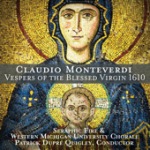This recording of Monteverdi’s Vespers of 1610 rose to No. 1 on the iTunes classical chart the weekend of August 20th and briefly bettered a Lady Gaga album on the iTunes all-genre chart that Sunday. This might be a sign that the performance is rigged somehow, that it includes bells and whistles, that it alters the music for a “modern” sensibility. In fact it is somewhat revolutionary, if that’s a word that can ever be applied to something like this.
Working under the presumption that one meaning of the score’s inscription “suited for the chapels and chambers of princes” implied that if instrumental forces were unavailable then continuo and voices would suffice, conductor Patrick Quigley and his singers and players (one each on lute, theorbo, and violone, and two chamber organists) here offer a skeletal view of the Vespers. The result is fascinating–almost a look through the work, an image of the architectural design without accoutrements or wall hangings, with the vocal polyphony to the fore.
And Quigley claims that this is the way Monteverdi presumed he would hear it and probably did hear it during his lifetime, San Marco being the exception. Just to get the whole argument out of the way, Quigley has no proof of this, and besides that, I think he’s wrong: the “Sancta Maria” specifically asks for instruments. How does Quigley handle the contradiction? He eliminates the “Sancta Maria” entirely.
This cannot and should not be one’s only recording of this work, but it serves a terrific purpose and is in itself a fine performance. It certainly sounds more Renaissance than Baroque without cornetts, sackbuts, a string ensemble, and other frou-frou, and Monteverdi’s intricate polyphony, disencumbered of contrapuntal instrumentation, is heard in all its glory. But then again, so it is with many of the other available, fully “encumbered” recordings (Robert King’s on Hyperion being a particularly fine–and transparent–reading, with another equally worthy dozen to choose from).
So what we have here is a finely tuned, beautifully judged reading, with 42 choristers (those princes had big enough “chambers” for 42 singers plus soloists and five continuo players?), all of whom sing with the knowledge that they have no instrumental back-up and with impeccable pitch: the choral sopranos are right on the money. Soloists are also quite fine, the tenors particularly good (all three voices in “Duo Seraphim” have the all-important “goat-trill”). The alternations in tempo in the “Ave maris stella” seem affected, and I hate that Quigley slows down for the end of the “Duo Seraphim” for a barbershop trio event, but otherwise tempos are wonderfully and wisely managed.
Occasionally you feel that one major track of the recording has been accidentally left off–the instrumental track–such as in the “Lauda Jerusalem”, which really needs more grandeur, but in general this is an interesting experiment. The Magnificat is the one for six voices, and some of it is revelatory in its stripped-down form, although the female voices go awry in the “Esurientes”. The omission of the Sancta Maria allows for a single 78-minute CD, so it’s a bargain.
You’ll know whether or not you need this–fascinating, ear-opening, but to be accepted as an experiment. And, I suspect, not what Monteverdi wanted; this was, after all, the greatest audition piece ever, a work the composer sent to the Pope, not to a prince with chambers. [9/3/2010]
































